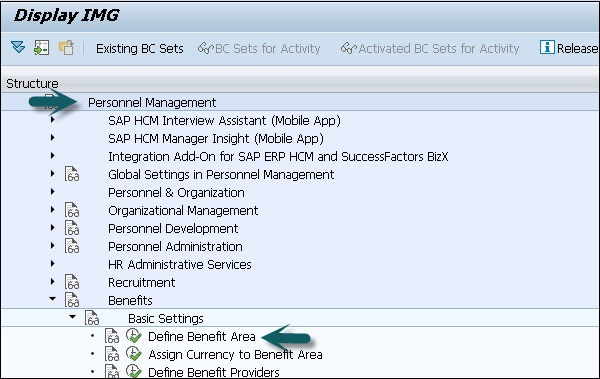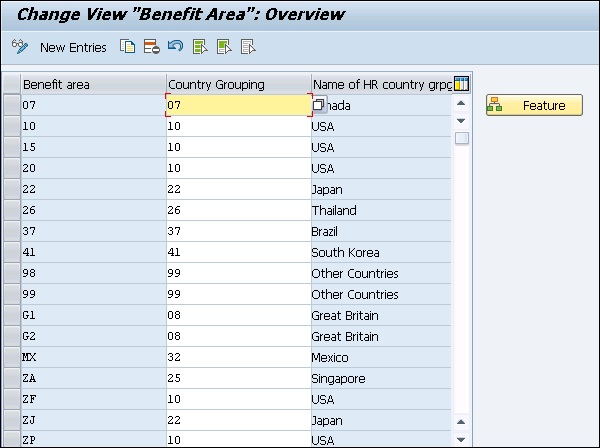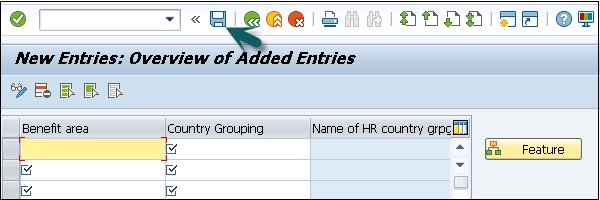
- SAP HR - Introduction
- SAP HR - Maintaining Relationships
- SAP HR - Time Constraints
- SAP HR - Maintaining Infotypes
- Personal Administration
- SAP HR - Personnel Administration
- SAP HR - Master Data
- SAP HR - Infotypes
- SAP HR - Personnel Actions
- SAP HR - Changing Infotypes
- Time Management
- SAP HR - Time Management
- SAP HR - Work Schedules
- SAP HR - Public Holiday Calendar
- SAP HR - Attendance Absences
- Benefits
- SAP HR - Benefits
- Payroll
- SAP HR - Payroll Management
- SAP HR - Basic Pay Infotypes
- Primary and Secondary Wage Types
- SAP HR - Payroll Process
- SAP HR - Gross Pay
- SAP HR - Payroll Cycle
- SAP HR - Universal Work List
- SAP HR Useful Resources
- SAP HR - Quick Guide
- SAP HR - Useful Resources
- SAP HR - Discussion
SAP HR - Benefits
The Benefit section in SAP HR management allows you to use the benefit tools for custom benefits provided by an organization to its employees. Benefits play an important role in employee retention to keep the best possible employees in a company.
Benefits Management in SAP HR is integrated with the international Payroll component. However, integration is not supported for every country version of SAP Payroll.
To use Benefits Management for a country payroll, which is not integrated, in conjunction with non-SAP payroll software or an external payroll service, you must provide your own interface for the transfer of data.
Enrollment Overview
Enrollment is a process of enrolling employees of an organization under the benefit management. Enrollment Plan selection for an employee depends on employee eligibility.
The Enrollment function allows you to enroll the employees and to make changes to the employee benefit selection as required for the following tasks −
u2022 − Enrollment of employees during an open enrollment period in plans for the coming Season.
u2022 − Enrollment of new hires in plans that are automatically offered.
u2022 − Enrollment of new hires in default plans as an interim measure, until they have made their benefits choices.
u2022 − Adjustment of plan enrollments as a result of employee life or job changes.
Types of Enrollment
Following are the types of enrollment that can be used −
Open Enrollment Offer
An open Enrollment offer is the most unrestricted type of offer.
Important features −
Open enrollment type is generated by the system when you start enrollment for a date that lies within an open enrollment period.
It includes only those enrollment plans, which require the employees to meet some certain criteria. This is defined in customizing the field in SAP HR system.
Open Enrollment period is called the time period when an organization allows its employees to enroll in new benefits plans or change any existing enrollment plan.
Enrollment plans, which are available for selection during the open enrollment start on some specific future data and normally at the start of the new financial year.
The benefits offer set up for open enrollment is valid only during the open enrollment period.
Example
Consider an organization that allows an employee to select its benefits on an annual basis for the coming year. The open enrollment period is 1 Sep 2015 - 30 Sep 2015 and any new benefits that are elected by employees are valid from 1 Apr 2016 to 31 Mar 2017.
Default Enrollment Offer
A dynamic enrollment offer is called when employees can be enrolled before they communicate their benefits elections to the benefits office.
These default plans are commonly used for giving short-term coverage to new hires and therefore often allow little flexibility to the employee regarding the plan terms.
Automatic Enrollment Offer
Automatic enrollment plan is one in which the employees are enrolled without the requirement that they consent to the enrollment or make any elections within the plan. It allows an employee to enroll in all relevant automatic plans at all times.
Automatic Enrollment plans are normally provided to the employees at no extra cost and also allow little flexibility to the employee regarding the plan terms.
Adjusted Enrollment Offer
An organizational change or a personal change for an employee that allows an employee to change his/her current benefit elections.
The adjustment reason is normally a user-defined parameter to which certain adjustment permissions are assigned for different types of benefit plan.
Some examples of adjustment reasons are Marriage, Hiring (initial enrollment), New dependent, Job change etc.
Benefit Area
Using Benefit areas, you can have separate administration of different benefit plan pools. The division is performed primarily for administrational purposes and would not normally be used for eligibility. This is a primary subdivision of plan set up within the benefits component.
Benefit areas in SAP HR are independent from each other. They are configured and function independently. Typically, employees will be enrolled in a benefit area that groups them according to common attributes such as country or organizational assignment.
Step 1 − To define benefit area, go to SPRO → IMG → Personnel Management → Benefits → Basics Settings → Define Benefit Area → Execute.

| 01 | Germany |
| 02 | Switzerland |
| 03 | Austria |
| 04 | Spain |
| 05 | The Netherlands |
| 06 | France |
| 07 | Canada |
| 08 | Great Britain |
| 09 | Denmark |
| 10 | USA |
| 11 | Ireland |
| 12 | Belgium |
| 13 | Australia |
| 14 | Malaysia |
| 15 | Italy |
| 16 | South Africa |
| 17 | Venezuela |
| 18 | Czech Republic |
| 19 | Portugal |
| 20 | Norway |
| 21 | Hungary |
| 22 | Japan |

Step 2 − To create a new Benefit area, click New Entries. Enter the fields - Benefit Area, Country Grouping, Name of HR country grpg.
Once you enter the details, click Save.

Benefit Category
Benefit category defines the classification of benefit plans. Benefit category is always maintained in SAP HR system. Given below are the key benefit categories −
- Health Plans
- Insurance Plans
- Savings Plans
- Stock Purchase Plans
- Flexible Spending Accounts
- Credit Plans
- Miscellaneous Plans
In SAP HR system, all these categories are predefined and HR system handles each category differently. Benefit plan types are defined within each category to reflect your requirements.
Benefit Category is at the highest level in Benefit Plan structure. Benefit Categories are again divided into Plan types and every category can contain one or more Benefit Plan types.
Benefit Plan type
The grouping of different benefit plans is done in Benefit Plan type. You identify each benefit plan with a unique identifier - maximum four characters.
Following are common Benefit plan types −
MEDI − stands for Medical plan and belongs to Health Plan Category
SAVE − stands for Savings and belongs to Savings Plans Category
STPC − stands for Stock purchase and belongs to stock Option Category
DCAR − stands for dependent care spending and belongs to flexible spending Accts
LIFE − stands for Life Insurance and belongs to Insurance Plans Category
CRED − stands for flex credit and belongs to Credit Plans Category
CAR − stands for Company car and belongs to Miscellaneous Plans Category
Benefit Plan types are used for enrollment and the system does not allow an employee to enroll in more than one benefit plan per plan type.
Benefit Plans
Benefit plan structure at the granularity level is defined by Benefit Plans. You can group multiple Benefit plans under a particular plan type. All the benefit Plans are identified with a unique identifier, which consists of maximum of four characters as mentioned above.
Example
MEDI, VISI, DENT represents health Plans Category for medical MEDI Plan Type.
Benefit plans within the health plan category cover the basic health needs of an employee. A typical health plan might provide an employee with medical, dental or vision coverage.
Similarly, you can have an Insurance plan, which is used to provide monetary amounts of coverage payable to the employees in an organization.
To setup account balance to meet spending needs, a spending account can be used that provides an employee with the opportunity to establish account balances. Most common needs that can be associated with spending account includes health, dependent care, and legal benefit, etc.
Example
Following are the common benefit plan types for each of the plan categories −
Health Plans
- General medical care
- Dental care
- Vision care plan
Insurance Plans
- Life insurance
- Dependent life insurance
- Supplemental life insurance
Savings Plans
- Retirement plan
- Savings plan
Stock Purchase Plans
- Own company stock plan
- Flexible Spending Accounts
Health care spending account
- Dependent care spending account
Credit Plans
- Cafeteria plan
Miscellaneous Plans
- Company car